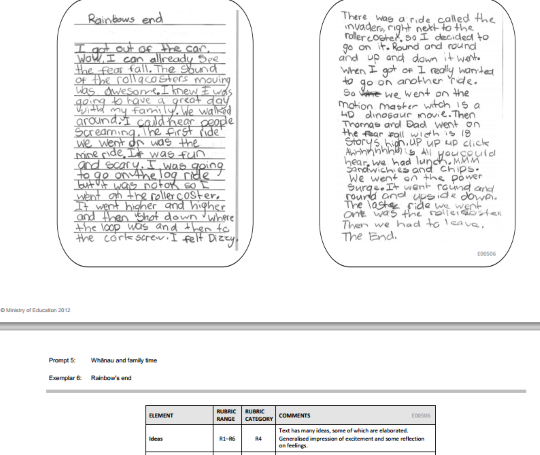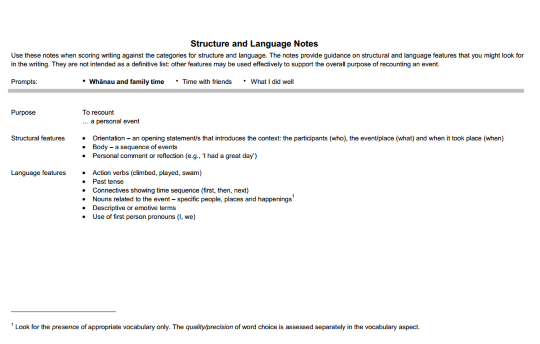Writing – scoring and moderation
e-asTTle writing assesses a student’s ability to independently write continuous texts across a variety of communicative purposes.
The purposes are to:
- describe
- explain
- recount
- narrate
- persuade.
Within each purpose, there is a range of "prompts". You will be asked to select a purpose, and then a prompt, when you create an e-asTTle writing test.
See Choosing a writing/tuhituhi prompt for more information.
If you have made up your own prompt
You can use the e-asTTle scoring rubrics to assess a prompt you made up. However, do not put any scored results for your prompts into e-asTTle. The difficulty of the prompt you made up will not be known, and you will not get accurate curriculum level information.
Which students can use the writing tool
The writing tool has been designed for use with students from Year 1 to 10. Students should be able to write at least one or two simple ideas. If you find, after using the Writing tool, that students are scoring in the lowest category (rubric score 1) for each element, they are probably not well-targeted for the e-asTTle assessments.
How writing is scored
Writing is now based on seven "elements": Ideas, Structure and Language, Organisation, Vocabulary, Sentence Structure, Punctuation, and Spelling.
The curriculum levels are not used as part of the marking. Instead, you will have to select a rubric score (ranging from 1-6, or sometimes 1-7). This will be translated into a curriculum level which is available when you view reports.
Download the generic exemplar and scoring rubric:
Three parts of the scoring rubric document that you need to use to make scoring decisions
- The scoring rubrics themselves
- The annotated exemplars
- The Structure and Language notes
Together, the marking rubric, the structure and language notes and the annotated exemplars provide the means by which consistent scoring judgments can be made.
Using the scoring rubric
Each element of writing should be scored independently. The “skill focus” statement for each element (located at the top of each page on the rubric) provides guidance on the main focus of each element. For example, when scoring the vocabulary element, the focus is on the range, precision and effectiveness of words, rather than on the accuracy of spelling. Spelling is the focus of a separate element.
The descriptors within each category score are hierarchical and cumulative. To assign a category score of R4 in a particular element, the conditions for a score of R3 in that element must also have been met. However, within each category, it is important to note that a minor error or glitch is allowed.
Rubric scores and curriculum levels are distinctly different things. Category R3 does not translate to curriculum level 3.
An R3 for Spelling and an R3 for Structure and Language map to very different curriculum scores.
The prompts have been designed to stimulate continuous text on topics that are accessible to students, which provides opportunities for individual interpretation. The topic outlined on the prompt (“being a good friend”) is therefore intended as a springboard for writing, rather than as a tightly defined focus.
Although each prompt specifies a purpose, the marking rubric accommodates the use of multiple purposes. For example, if the specified purpose is to describe and the student also explains, only the descriptive features are scored within the structure and language element. The explanatory features can contribute to the student’s score for the ideas element.
Ongoing moderation of scoring decisions is necessary to ensure that scoring is consistent and accurate over time.
Using the exemplars
There are 76 exemplars of student writing, designed to help you make scoring decisions. The specific exemplars are examples of writing for the prompt being used. You will find these inside the scoring rubric. The generic exemplars cover the full range of abilities, but may not necessarily use the same purpose or prompt. There is a link to the generic exemplars on the Mark screen, or you can find them by going to View Existing Tests" and choosing "Print Options".
Take time to become familiar with the scores and characteristics of the exemplars. Referring back to the exemplars on a regular basis will help ensure that marking does not “drift” over time.
The exemplars are actual samples of real student writing – they are not designed to be "ideal" examples, but rather, representative samples of writing.
Using the Structure and Language notes
The Structure and Language notes are specific to a prompt. They provide guidance for the features you might look for in students’ writing. You will find the Structure and Language notes after the rubrics and before the annotated exemplars, inside the scoring rubrics document.
Select text version of this image here.
Moderation
If several teachers within the school are using e-asTTle writing, group marking and moderation of students’ work can be a useful means of developing a shared understanding and a consistent approach.
Considerations when marking
- Mark the test on the basis of the evidence in front of you – not based on the student’s age, or any other information you know about the student who wrote it.
- The neatness of handwriting should not come into your marking decisions – there is no scoring rubric for handwriting neatness.
- A rubric score on one element may have a very different meaning to a rubric score on another element. Do not be concerned if, for example, a student is at an R6 on one category and an R2 on another.
During the development of e-asTTle Writing, a manual was written to accompany the Writing tool. The Writing manual is available for download below. Part A contains information about the tool, marking and administration and interpreting reports. Part B contains in-depth technical information on how the tool was constructed.
- Related information




